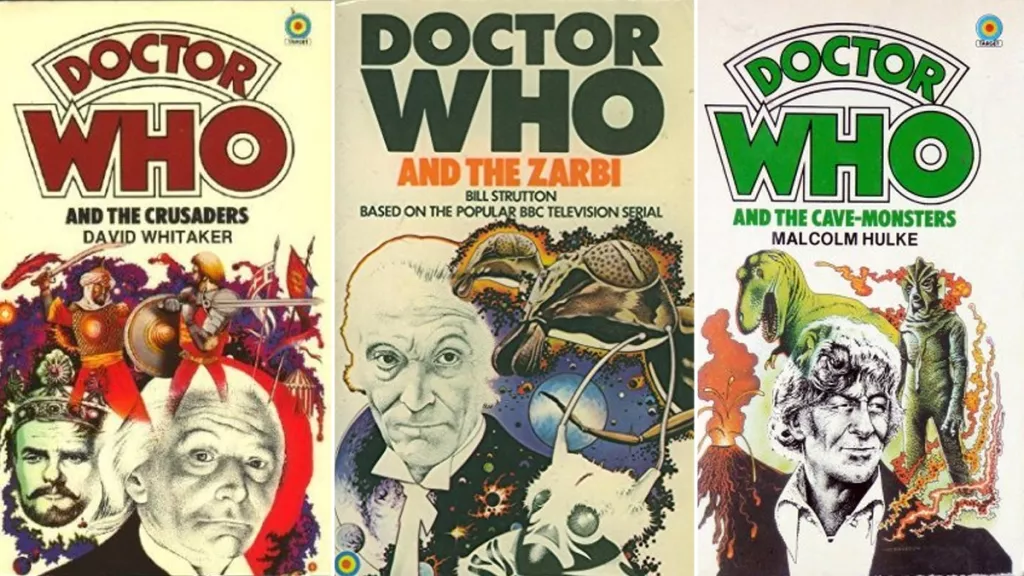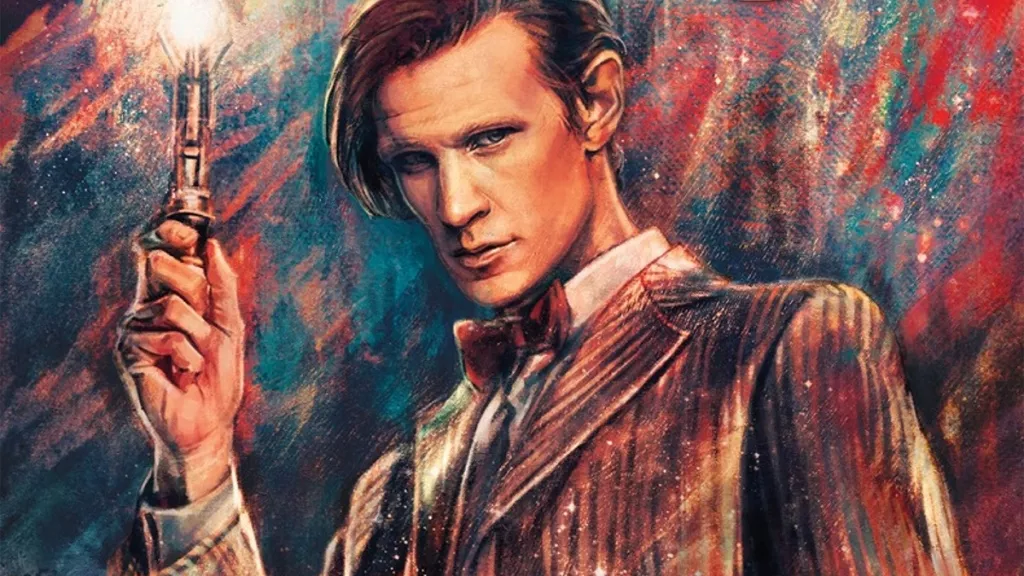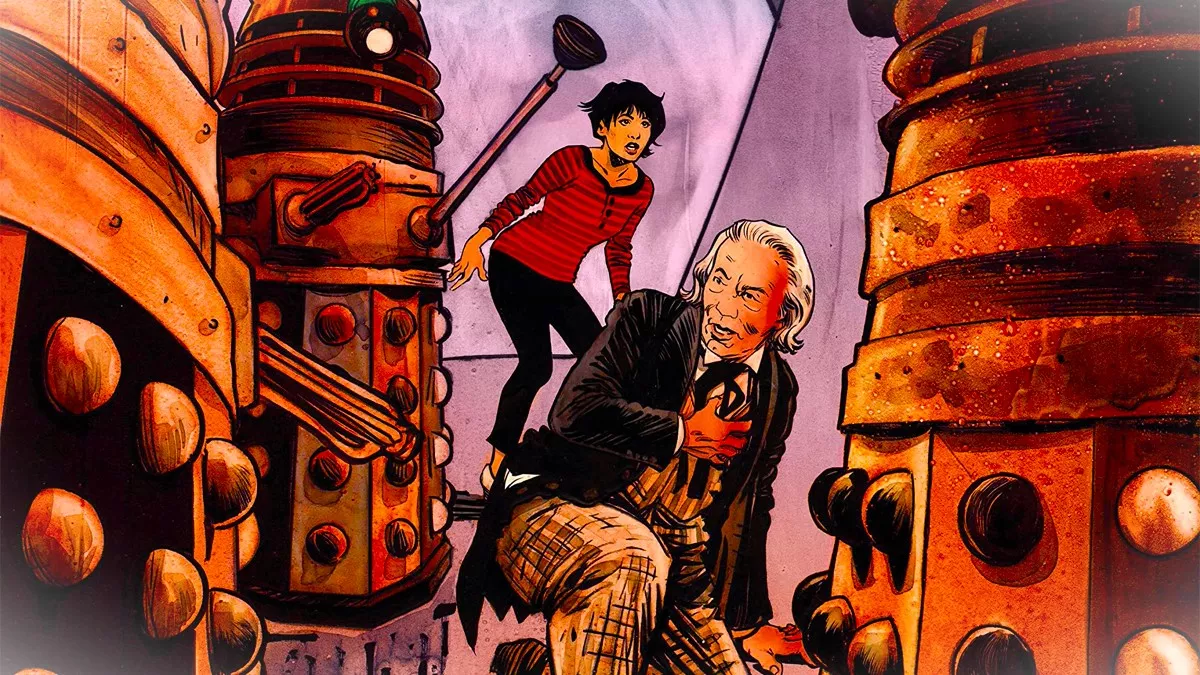A new edition of David Whitaker’s “Doctor Who and the Daleks,” the first-ever Doctor Who novel published in 1964 under the title “Doctor Who in an Exciting Adventure with the Daleks,” has been released by BBC Books. This re-release, presented in hardback format, features stunning illustrations by American artist Robert Hack, known for his work on the IDW Comic range since 2008 and his contributions to the comics and TV title sequence of “The Chilling Adventures of Sabrina.”
Hack’s art in this edition is a remarkable blend of the original monochrome TV series, Whitaker’s prose, and the vibrant Peter Cushing movie adaptation from 1965. While some bold colors reminiscent of Cushing’s film are present, each painting is dominated by a single color, creating a monochromatic feel without relying solely on shades of gray. With Whitaker’s creative freedom unconstrained by TV budget limitations, Hack is able to depict scenes on a larger scale than the original, intensifying the horror in certain moments, particularly in the chilling depiction of the Dalek mutants. Whitaker’s revisions are also captivating, treating the book as a potential entry point for new readers into the series and introducing a fresh way for the characters to meet. Additionally, he presents an idea for a Dalek that would later be realized in the TV show more than two decades later. However, the novel retains much of the story as fans remember it, albeit narrated from the perspective of Ian Chesterton.
Originally commissioned by Frederick Mueller Ltd., the novel was released to coincide with the Daleks’ second TV appearance in “The Dalek Invasion of Earth.” Despite the tight deadline of nine months, from Whitaker’s initial contact in February to the book’s publication in November, the novel capitalized on the growing Dalekmania of the time and enjoyed successful sales, leading to two reprints. Subsequent titles were commissioned, including Bill Strutton’s “Doctor Who and the Zarbi,” a novelization of “The Web Planet,” and Whitaker’s adaptation of “The Crusade” as “Doctor Who and the Crusaders” in 1965 and 1966, respectively. However, these later adaptations did not achieve the same level of success, possibly due to the absence of Dalek involvement, resulting in no further stories being adapted.
Target: Cultivating a Love for Reading Across Generations
In 1972, a significant milestone occurred in the history of Doctor Who books. Target Books was established as a children’s imprint under Universal-Tandem. During the search for suitable material to publish, an editor stumbled upon three Doctor Who adaptations among existing publishers. Eager to secure the rights, the editor obtained permission to release these adaptations in paperback, approaching the BBC production team afterwards. Barry Letts and Terrance Dicks, in particular, were enthusiastic about the idea, with Dicks volunteering to write the adaptations himself. The initial reprints enjoyed considerable success, prompting the release of additional adaptations like ‘Doctor Who and the Auton Invasion’ (a reworking of ‘Spearhead from Space’ by Terrance Dicks) and ‘Doctor Who and the Cave Monsters’ (based on ‘Doctor Who and the Silurians’ by Malcolm Hulke). With the inclusion of stories featuring the current Doctor, Jon Pertwee, the range began on a strong note.
The Target Doctor Who books, characterized by their concise writing style, are widely acknowledged for their instrumental role in cultivating a new generation of readers. In the 1970s, alongside the fiction aimed at younger readers, there were non-fiction tie-in books available. However, as the 1980s unfolded, the audience for these books started to shift towards older and more dedicated fans. Recognizing the inevitable point when all the television stories that could be adapted would be exhausted, Target made efforts to launch spin-offs, featuring companions like Turlough and Harry Sullivan, and adapting stories from the abandoned version of Season 23. As the number of new TV stories decreased, the range ultimately concluded in 1990 with an adaptation of the 1969 episode ‘The Space Pirates,’ peculiarly released with the logo from the McCoy era. For those seeking obscure trivia, it’s worth noting that the final book released in the Target range was a reissue of ‘Talons of Weng-Chiang’ in 1994 (a fact that may only interest a niche audience).

Even in their concise form, these books often deviated from or expanded upon what was depicted on screen. As more writers were given the opportunity to adapt their own work in the 1980s, some took advantage of the medium by basing their novels on alternate drafts or exploring different perspectives. A notable example of this approach was Donald Cotton’s adaptation of ‘The Romans,’ which took the form of letters collected by Tacitus. The adaptations of the Seventh Doctor’s stories were particularly noteworthy in this regard, as they added significant content not found in the televised versions. For instance, there were chapters narrated from the perspective of the Special Weapons Dalek, the Doctor assuming the role of Merlin, or an epilogue featuring an older Ace after her departure from the TARDIS. These creative additions enriched the reading experience and offered fresh insights into the Doctor’s adventures.
The Unexplored and Absent Tales: Doctor Who’s Untold Journeys
The New Adventures line was born out of Virgin’s acquisition of WH Allen, who owned the Target Imprint at the time. The line was established when it was still profitable, with consistent and predictable sales, and only a few stories left to adapt. Initially, TV Producer John Nathan-Turner resisted creating original novels as long as there were stories to adapt. However, with the dwindling number of stories, the line was developed further, featuring the Seventh Doctor and various companions. The books in this new line grew in length and scope, reflecting the trend of recent novels becoming more expansive.
Later, the ‘Missing Adventures’ range was introduced, which focused on past Doctors and companions. These books served as a blend of homage and attempts to capture the tone of the show across different eras. They also took advantage of the expanded storytelling possibilities introduced by the New Adventures books.
In retrospect, the quality of the New Adventures varied from book to book. However, at their best, they pushed the boundaries of what Doctor Who could achieve, not just in terms of concepts and scale, but also emotionally. Amidst occasional instances of gratuitous content, there were moments that shed new light on the show and its central character. Among the acclaimed authors of the range, Paul Cornell stood out, as his work resonated with audiences and even led to the adaptation of his novel ‘Human Nature’ for television. Additionally, Russell T. Davies incorporated elements from Cornell’s book ‘Damaged Goods’ into the 2005 series of Doctor Who.
BBC Books: Catalyst for the TV Resurgence
In 1996, BBC Books, a division of BBC Worldwide at the time, acquired the rights to publish Gary Russell’s novelization of the TV Movie. As a result, Virgin’s license for Doctor Who books was not renewed. This change led to the emergence of two new lines of Doctor Who fiction: The Eighth Doctor Adventures and The Past Doctor Adventures. Initially, these new lines aimed to be less explicit and more suitable for a family audience, but they lacked a clear direction. However, things began to come together to some extent when Stephen Cole assumed the role of editor. Ironically, Cole left in 2000 after writing a book that destroyed Gallifrey, along with several unresolved plot threads, in order to provide a fresh starting point for Justin Richards to take over the line. Little did they know that five years later, Russell T. Davies would do the same thing for himself.

The BBC Books lines initially enjoyed success and showcased numerous creative highlights and ideas that later appeared in the post-2005 TV series. However, over time, their sales dwindled to the extent that even critically acclaimed titles like Simon Guerrier’s ‘The Time Travellers’ struggled to recoup their advances. In 2005, these lines came to an end following the return of the TV show, making way for the BBC New Series Adventures. Additionally, BBC Books was sold to Random House in 2006.
The new series adventures featured paperback-sized hardbacks that focused on the current Doctor. The nine releases in 2006 alone sold an impressive 321,230 copies. These releases continued in sets of three until 2012, while standalone titles made their debut in 2010 with contributions from authors such as Michael Moorcock, Dan Abnett, and Jenny Colgan, who wrote stories featuring the Eleventh Doctor.
Meanwhile, the return of past Doctor stories was underway. In 2011, Gareth Roberts adapted ‘Shada,’ an unfinished Season 17 story by Douglas Adams that had been disrupted by labor strikes. This story was one of the novels that Target Books had been unable to publish during its initial run (all of which have now been adapted). Furthermore, reprints of Target novels began, and Stephen Baxter initiated an annual series of past Doctor novels by esteemed writers. The series kicked off with ‘The Wheel of Ice,’ featuring the Second Doctor, Jamie, and Zoe, followed by Third and Fourth Doctor novels by Alastair Reynolds and A.L. Kennedy, respectively, in the subsequent years. Additionally, two sets of novellas were published, one by Puffin in commemoration of the 2013 anniversary and the Time Trips range in 2014.
The Exciting New Series Adventures and the Anticipated 60th Anniversary
In 2013, the New Series Adventures made a comeback with a single set of three books. However, the ongoing original audio stories came to a halt when AudioGo ceased operations. Following this, Random House rebranded the imprint as BBC Audio and released audiobooks of the Twelfth Doctor novels in 2015. The Twelfth Doctor’s adventures were published in one set of books per year, and then three novels featuring the Thirteenth Doctor were released in 2018. These marked the final set of New Series Adventures published. However, BBC Children’s Books released three titles between 2018 and 2021, authored by David Solomons and Jacqueline Rayner. Additionally, the same publisher issued two ‘Team TARDIS Diaries’ books in 2021, with the second half of the series yet to be released. In 2020, a standalone novel titled ‘At Childhood’s End,’ written by Sophie Aldred (the actor who played Ace), was published. Its consistency with the TV canon following Ace’s appearance in 2022’s ‘The Power of the Doctor’ remains uncertain, but historically, such considerations have not deterred fans.
There is a clear sense of the book ranges experiencing both gains and losses in momentum. So, where can Doctor Who books venture from here? Plans are likely underway for the 60th anniversary year, and at the very least, the possibility of a new line of tie-in novels for David Tennant and/or Ncuti Gatwa’s Doctors will be explored. The scale and target age groups of these releases are yet to be determined. Recent books have catered to a younger audience, and there is no apparent reason not to continue appealing to that age group while also publishing titles suitable for the entire family. It would be surprising if there were no future tie-in fiction in store for Doctor Who. With that in mind, what would you like to see in the future of Doctor Who books?
